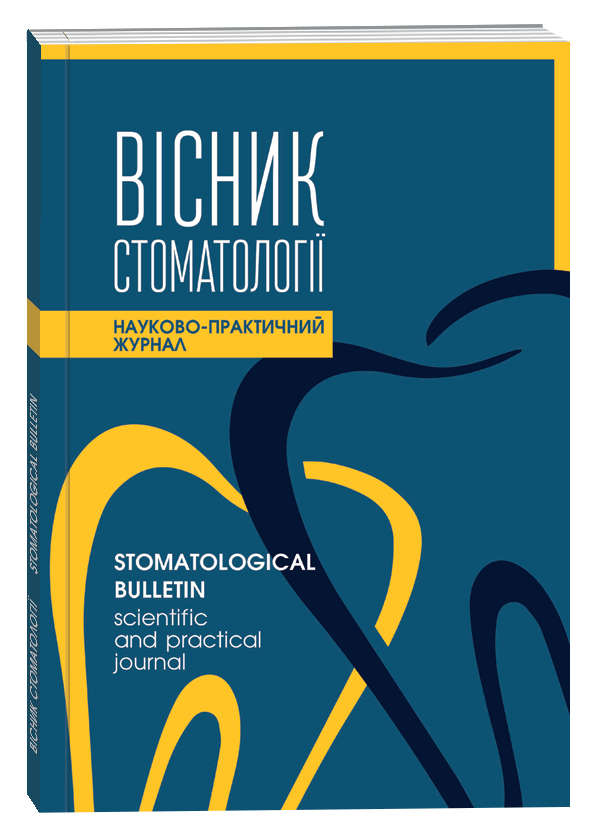CURRENT TRENDS IN DENTAL CARIES PREVENTION: LITERATURE OVERVIEW
DOI:
https://doi.org/10.35220/2078-8916-2020-37-3-85-87Keywords:
caries, prevention, surgical model, antibiotic model, probiotic approach, fluoride, caries vaccineAbstract
Introduction. It is known that the main dental diseases in general, and dental caries in particular, are considered manageable and can be prevented, but their prevalence is increasing from year to year. At the present stage, the system of prevention of dental diseases is becoming in-creasingly important.
Aim. The given article is dedicated to the overview of the current trends in dental caries prevention.
Results. Scientists single out traditional and modern ap-proaches to caries management. There are four main tra-ditional trends in caries treatment. They are surgical model, antibiotic model, probiotic approach, and caries balance concept. Nowadays more emphasis is being placed on dental caries prediction and caries risk analy-sis than mere detection of cavities which require immedi-ate filling. While in the past, the cavities were filled at their earliest detection, now the indications for restora-tive treatment have narrowed. Instead of restorative treatment, plaque control measures are employed to pro-mote remineralization and reversal of the dental caries process. Recent trends in caries prevention also include several approaches. One of the most widely applied is fluoride. One of the most widely studied now is caries vaccine.
Conclusion. Carrying out preventive measures for major dental diseases should be aimed, on the one hand, at eliminating etiological factors, and on the other hand, at increasing the resistance of hard and soft tissues of teeth and oral cavity, the body's resistance to adverse factors. The most common concepts of the etiology and pathogen-esis of dental caries and periodontal tissue diseases indi-cate a direct relationship with bacterial status, oral hy-giene and the level of body resistance. The experience in the prevention of dental caries showed that the most effec-tive is the prevention of an individual focus.
References
Lee Y. Diagnosis and Prevention Strategies for Dental Caries. J Lifestyle Med. 2013; 3(2). P. 107-109.
Harsh Priya, Peter S Sequeira, Shashidhar Acharya, Meghashyam Bhat, Bharathi Purohit, Manoj Kumar. Recent Trends in Preventive Dentistry - A Review. SRM University Journal of Dental Sciences. 2011.2(3):232-237.
Anderson MH, Shi W. A Probiotic Approach to Caries Management. Pediatr Dent. 2006; 28:151-153.
Featherstone JD. Prevention and reversal of dental car-ies: role of low level fluoride. Community Dent Oral Epidemiol. 1999; 27:31–40.
Petersen PE, Lennon MA. Effective use of fluorides for the prevention of dental caries in the 21st century: the WHO approach. Community Dent Oral Epidemiol. 2004;32:319-321.
Bretz WA., Rosa OP. Emerging technologies for the prevention of dental caries. Are current methods of prevention sufficient for the high risk patient? Int Dent J. 2011;61(1): 29-33. doi: 10.1111/j.1875-595X.2011.00027.x.
Jia R, Guo JH., Fan MW., Bian Z, Chen Z, Fan B, Yu F, Xu QA. Immunogenicity of CTLA4 fusion anti-caries DNA vaccine in rabbits and monkeys. Vaccine. 2006;12; 24(24):5192-5200.
Culshaw S, Larosa K, Tolani H, Han X, Eastcott JW, Smith DJ., Taubman MA. Immunogenic and protective poten-tial of mutans streptococcal glucosyltransferase peptide con-structs selected by major histocompatibility complex class II al-lele binding. Infect Immun. 2007;75(2):915-923.
Shanmugam KT., Masthan KMK., Balachander N, Jimson S, Sarangarajan R. Dental caries vaccine - a possible option? J Clin Diagn Res. 2013;7:1250–1253.
Smith DJ. Prospects in caries vaccine development. J Dent Res. 2012;91:225–226.









